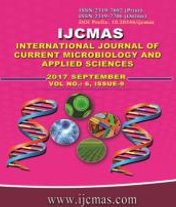


 National Academy of Agricultural Sciences (NAAS)
National Academy of Agricultural Sciences (NAAS)

|
PRINT ISSN : 2319-7692
Online ISSN : 2319-7706 Issues : 12 per year Publisher : Excellent Publishers Email : editorijcmas@gmail.com / submit@ijcmas.com Editor-in-chief: Dr.M.Prakash Index Copernicus ICV 2018: 95.39 NAAS RATING 2020: 5.38 |
The extensive study on biodiversity of aphidophagous syrphid flies were made in daffodil, Rose, chrysanthemum and wild flowers (including Dandelion, Fennel and Black Berry) of floriculture ecosystem of Kashmir during 2013 to 2014 and a total of 21 species were recorded. Among all, the Eristalis tenax (11.57% and 9.80%) was found most distributed and abundant syrphid species followed by Eoseristalis cerealis (10.49% and 9.00%) and Eupeodus corolla (9.12% and 7.63%) while as Syritta sp. (0.82% and 1.17%) followed by Palpada sp. (1.49% and 2.02%) were least distributed and abundant species of syrphid fly in daffodil, Rose, chrysanthemum and wild flowers (including Dandelion, Fennel and Black Berry) of floricultural ecosystem of all locations in Kashmir during 2013 and 2014, respectively. The species diversity was measured by the using Shannon-Wiener biodiversity index (H) and species richness by using Margalef’s richness index (Da) during 2013 and 2014. The highest mean species diversity (H!) of syrphid flies was found in Harwan of district Srinagar with 2.935 and the highest species richness (Da) was observed in Mamoosa of district Baramullah with 3.584 and 3.611 in Shalimar of district Srinagar of floricultural ecosystem of Kashmir.
 |
 |
 |
 |
 |